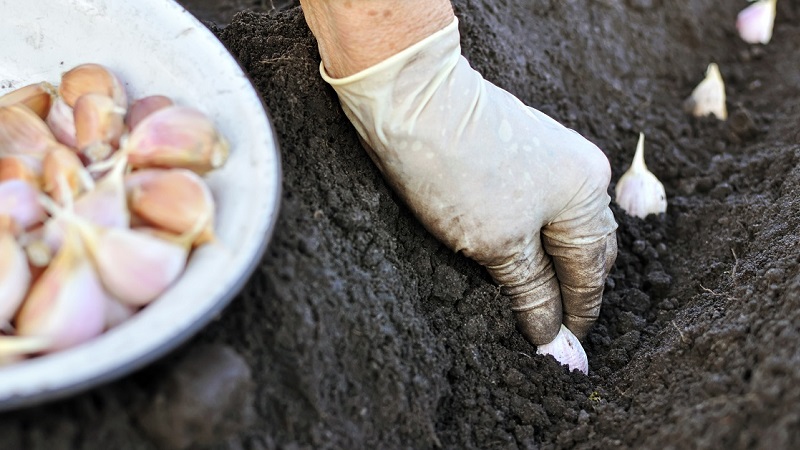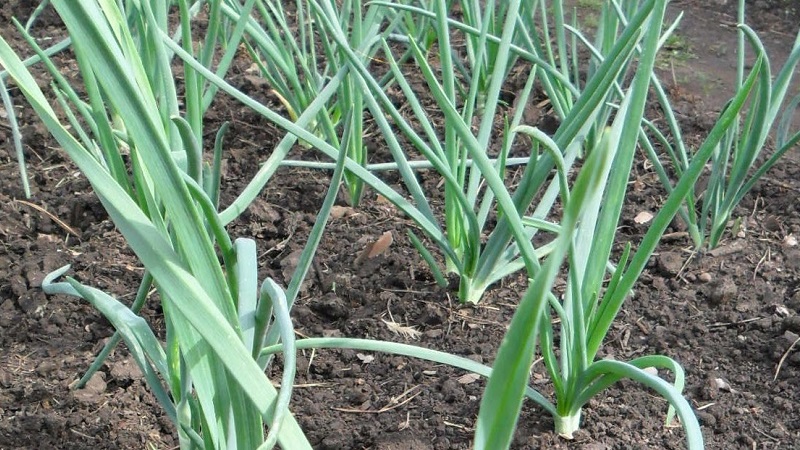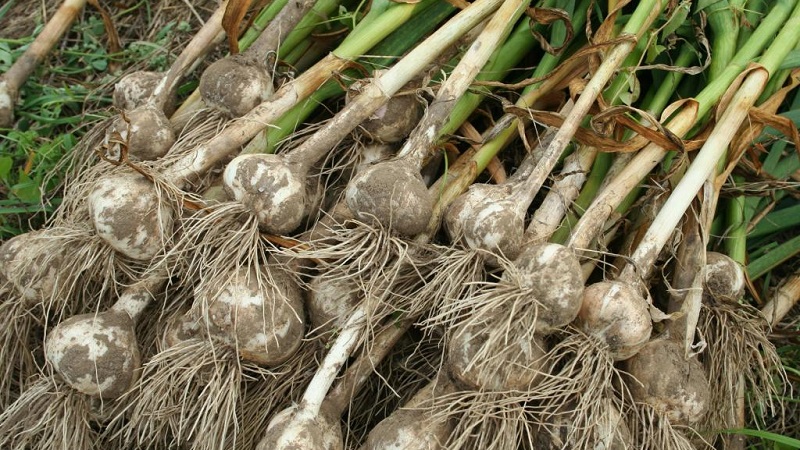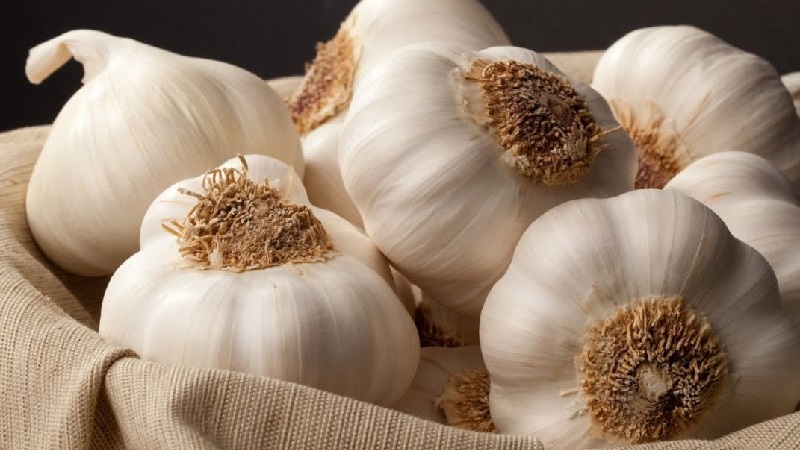What is spring garlic and how to grow it correctly: a step-by-step guide and secrets of experienced gardeners
Among the abundance of seasonings and spices, garlic is a recognized leader in popularity in many countries around the world. In addition to purely gustatory qualities, this culture is recognized as a natural remedy No. 1 by official and folk medicine.
Growing and caring for a culture is not difficult, the main thing is to know and observe the main stages of cultivation. From the article you will learn how to distinguish spring garlic from winter garlic, how to grow it outdoors, when to harvest and how to store it.
The content of the article
The difference between spring and winter garlic
All varieties of garlic are usually divided into winter and spring... Spring crops are planted in early spring, and winter crops are planted in autumn. Distinguishing one species from another is not difficult.
Winter crops are distinguished by a small number of cloves and their even number (from 4 to 6). The head can be compared to a tangerine: all the teeth are even, the same size and shape.

Spring cloves have much more, they can be of different sizes and shapes... Another difference is that in the center of the head of the winter crop there is a trunk - the dried base of the peduncle.
Important! Only spring garlic is suitable for long-term storage. Winter crops are eaten immediately or used for harvesting.
How to plant spring garlic
For planting spring garlic, select the largest intact clovesgently separating the garlic heads. It is better to do this just before planting so that the bottom of the teeth, from which the roots will appear, does not dry out.
Small slices are great for growing healthy tasty greens, only in this case it is better to choose a bed in the shade.
Selection and preparation of a site for planting
A well-lit, not damp place is suitable for garlic.... Excessive moisture can cause rot. In low-lying areas, growing vegetables is possible in high beds. Neutral soil works best. Sour soil is neutralized with chalk or dolomite flour.
The plot is being prepared in autumn... The earth is dug up, 6-7 kg of humus, about 25 g of superphosphates and 20 g of potassium salt are introduced for each square meter. Before planting spring garlic in the spring, the soil is loosened, leveled and slightly compacted.
The landing site changes every year - it helps to avoid diseases. It will be possible to return to the previous place in 4-5 years.
It will be interesting:
The best varieties of spring garlic
Preparation of planting material
Preparation of spring garlic for planting is determined by the method of storing the bulbs... If in winter they were stored at a temperature of about + 20 ° C, then the new bulbs will grow larger, but they may not have time to mature before the end of the season. If the heads were stored at a low temperature (+ 6 ... + 10 ° С), then the bulbs will grow smaller, but they will ripen.

Combining these two methods will help you get a stable harvest.... Store the spring garlic immediately after harvesting in a warm room, and 1-2 months before planting, put the bulbs in a cool place, such as on a balcony or refrigerator. The cooling time is determined by the size of the heads. The larger the bulbs, the longer they take to cool.
It is good to use cloves with overgrown roots for planting... To do this, the cloves of garlic are immersed in a solution of potassium permanganate for 30 minutes or soaked for a couple of hours in ordinary water. Then the water is drained, and the teeth are wrapped in a damp cloth and polyethylene and placed in a cold place for several days. The cloves with roots are planted carefully so as not to damage the processes.
To protect against pests, planting material is disinfected in 0.1% solution of potassium permanganate or 1% solution of copper sulfate.
Recommended Garlic Precursors
When choosing a place for planting, you should pay attention to the root system of the predecessor... Garlic bulbs have short roots, so minerals and fertilizers from the topsoil are actively used during growth. Accordingly, crops with a long root system will be preferred predecessors.
For reference.It is good to plant garlic after cereals, pumpkins, legumes, herbs.
Avoid areas where it used to grow carrots, potatoes, beets, onions, peppers, tomatoes.
Planting dates for spring garlic
There is no unequivocal answer to the question of when to plant spring garlic in open ground... The timing is determined by the climate of a particular region. Sowing begins when the soil warms up to + 3-5 ° C. Light frosts are not terrible for crops. You should not delay planting, otherwise the soil will not have enough moisture and the bulb will take root poorly.
The landing pattern is simple... On the prepared bed, furrows are formed with a depth of 3-4 cm at a distance of 25-30 cm from each other. The teeth are laid out with the bottom down with an interval of 10-12 cm and sprinkled with earth.

Care
Spring garlic care is easy... The plant needs watering and feeding, loosening the soil, removing weeds. Mulching the area with humus, peat or rotted compost makes maintenance easier.
Abundant watering is needed only in the first phase of growthwhen the vegetable builds up greens. Drying or yellowing feather tips signal a lack of moisture.
After 6-7 feathers grow back, a garlic bulb begins to form... During this period, watering is reduced. Excess water leads to disease and rot. The day after watering or rain, the soil is loosened.
In the second half of August, watering is stopped.
Tying garlic feathers
Tying garlic leaves in a knot is one way to increase yields... The point of the procedure is that at the last stage of growth, all the nutrients are delivered to the bulb, and not to the leaves. However, there is no scientific confirmation of the effectiveness of this method.
Tying is carried out a few days before harvest.... First you need to carefully weave the braid, and then make a knot at the end, being careful not to damage or break the feathers. Be sure to wear gloves to avoid injuring your hands.

Fertilization
Top dressing of spring garlic begins as soon as the first green shoots appear from the ground... The more leaves are formed in April-May, the larger the bulb will be.
Nitrogen fertilizer is applied first. It can be a solution of mullein in a ratio of 1:10, bird droppings in a ratio of 1:12, herbal infusion, humus or mineral fertilizing. After 14 days, feeding is repeated.
In late June - early July, the plant begins to form a bulb. Now it's time to apply potash-phosphorus fertilizers (for example, infusion of wood ash). Such feeding is done until mid-August.
Harvesting and storage of spring garlic
Drying of garlic feathers in August indicates ripening of the bulb... The garlic is ready to harvest. Cleaning is carried out in dry, warm weather.
The dug out bulbs are shaken off the ground and placed in a dry, ventilated place.... It is preferable to spread the heads in rows or hang them.
After the green leaves are dry, they are cut at a distance of 4-5 cm from the bulb... Store garlic in cloth bags or cardboard boxes in a cool, dry place. Subject to the necessary conditions, the vegetable is perfectly stored for up to two years, without losing its beneficial properties.

Disease and pest control
Phytoncides contained in garlic do not save plant from pests and diseases.
Spring garlic amaze hoverflies, onion flies, moths, thrips, stem nematodes, root mites and garlic mites.
The appearance of insects is prevented by feeding with ammonium sulfate... If the pests do appear, then the affected plants are removed, carefully digging them up along with the roots.
Culture is not insured against diseases... This can be black mold, fusarium, downy mildew and white rot. The main reason for such diseases is excess moisture in the soil and poor quality planting material.
Little tricks and common mistakes
Errors in planting and growing:
- the use of low-quality planting material (damaged teeth are the cause of diseases and low yield);
- pressing the cloves into the soil during planting (deep planting delays the formation of roots);
- fertilization of a garlic bed with fresh manure (such feeding provokes infection of plants with fungal diseases);
- use for planting a site where bulbous crops previously grew (onion fly larvae love the leaves and bulbs of garlic);
- delay in harvesting (untimely harvesting leads to rupture of the integumentary scales and destruction of the bulb).
Little tips for care and planting:
- Using mulch, hay, and straw will prevent the soil and bulbs from overheating on hot days. The most active maturation of the head occurs at temperatures up to + 25 ° C.
- Compliance with crop rotation. It is fundamentally important to regularly transplant plants to another site, only in this case you can count on a good harvest.
- Marigolds, chicory, calendula, planted next to garlic beds, scare off onion fly and nematode larvae.
Read also:
Popular varieties of spring garlic
There are over 70 different varieties... From this variety, it is easy to choose a variety to your liking, given the climatic conditions, the characteristics of the site and the soil.

Here are the most popular varieties:
- Abrek - mid-season, large, well kept, not too sharp, light scales, white teeth.
- Aleisky - mid-season, the bulb is round, flat, stored until spring.
- Gulliver - medium late, fruitful, round bulb, slightly flat, light scales. Little susceptible to diseases and pests.
- Yelenovsky - mid-season, fruitful, round heads. Outside, the color of the scales is whitish, and inside, on the teeth themselves, it is pinkish. The variety is resistant to disease.
- Sochi-56 - mid-season, gives a stable and high-quality harvest. The head shape is slightly flat, rounded. The color of the scales can be white or purple, and on the teeth themselves - pink with a purple tint. The variety is resistant to disease.
Conclusion
With proper soil preparation and adherence to planting technology, growing garlic in the open field will not cause much trouble. All known rules and recommendations for growing spring garlic are important to apply wisely, taking into account your own experience and climatic conditions of the region.
Pay due attention to the plantings and in gratitude for the work you will receive a generous garlic harvest.